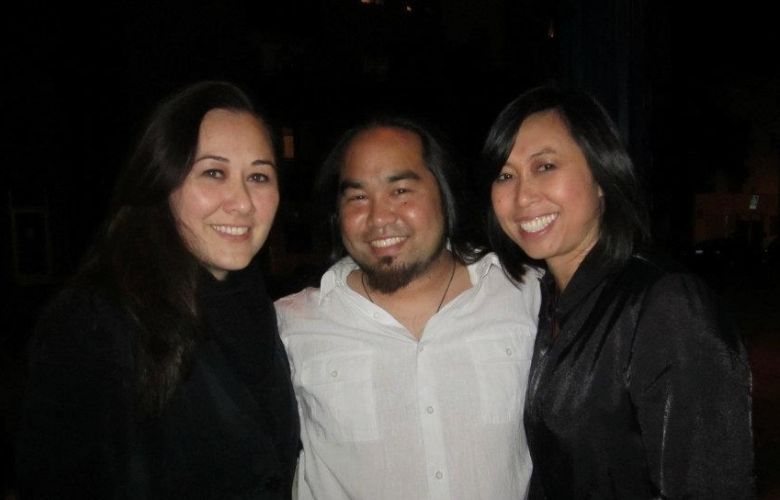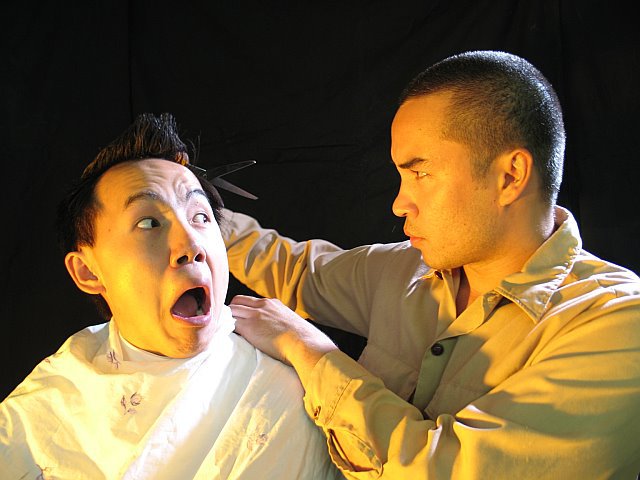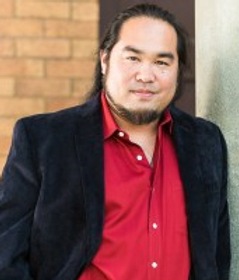
Andy Lowe is an award-winning playwright, director, producer and performer who has held multiple roles in his career. He is the co-founder of the San Diego Asian American Repertory Theatre, and is a board member and participant for various Asian American community organizations including the San Diego Chapter of the Organization of Chinese Americans and SD Alliance for APIAs.
Through his own “Chinese Pirate Productions,” he has directed and/or produced John Doe: The Musical by Robert Moutal, the musical Paul Gauguin by K.L. Brisby, Woman in the Mirror by Devra Gregory, Golden Child by David Henry Hwang, Gam3rs the Play and a nationally acclaimed stage adaptation of Joss Whedon’s Dr. Horrible’s Sing-Along Blog, which he directed, produced and adapted with musical director Brian Hammond.
Andy left San Diego for Los Angeles in 2013, and serves as Director of Casting & Production for the East West Players, the longest running theatre of color, and largest professional producer of Asian American work in the nation.
As an online personality, Andy has also been recruited by Pop culture streaming network “The Geekish Network” where he hosts two weekly Podcast shows; Pan-Geekery, and Pod Squadron Podcast.
As part of our series celebrating Asian American and Pacific Islander Heritage Month in May, we are shining the spotlight on our AAPI friends working across the Arts and entertainment industries.
Getting by. Its not lost on me that “Asian American Pacific Islander Heritage” shares a month with “Mental Health Awareness”. That could be an inside joke or kismet.
I probably ACTUALLY started in theatre as “Kid Brother” – some of my earliest memories were being babysat backstage during rehearsals for a production of David Henry Hwang’s Fresh Off The Boat that my sister performed in. This was San Diego’s First AAPI theatre company “The Pacific Asian Actors Ensemble” back in the 1980’s. The company was founded by Thom Sesma, along with my sister Gingerlily Lowe Brisby, and a handful of local AAPI actors in 1979, so growing up around that, and the eventual theatre for youth company that she and my Brother in Law Kent Lee Brisby founded (Asian Story Theater) I was always kind of theatre adjacent. I didn’t necessarily act or write myself, but I was around the process so much of my life.
Personally I saw myself as a visual artist, my sights were set on graphic novels and animation. I was still crafting stories in my head; they just usually involved superheroes, science fiction or mythology. During that time there was a boom in the comics industry, Batman had a movie, there was new Star Trek on the air, and Disney Animation was beginning its renaissance, and I was a kid with a sketchbook in my hand.
It was a great time to really see the potential for social change from storytelling; in the early 90’s there was Joy Luck Club, Dragon the Bruce Lee Story, Mulan Animated Feature, DHH just won a Tony. On TV you had Vanishing Son, Tia Carrere was playing a Tomb Raider knock off, and Hong Kong action cinema was starting to permeate the zeitgeist.
But just as quickly as it had boomed, it had started to fade, and I was still an angsty Grunge Gen X-er that was kinda dismayed that it was so short lived.
So I had an opportunity to develop some ideas I had started as a graphic novel, through a group called ‘the playwrights project’. They do an annual statewide “plays by young writers” festival and I was able to do some workshopping through them. The idea was to compare some of my personal identity crisis of being “THE ONE ASIAN” in a mostly a white neighborhood as a teen, and comparing that with a Journey to the West story where the Monkey King battles an evil doppelgänger who sullies his reputation, and no one will believe there’s an imposter on the loose.

There was a healthy dose of reacting to anti-Latinx and anti-immigrant sentiments that were bubbling up from NAFTA, and Prop 209. I was also heavily influenced by the Theatre for Youth shows spearheaded by my brother-in-law KL Brisby and sister Gingerlily had been doing through Asian Story Theatre.
It was before I had the opportunity to learn any Asian American studies, so it was me trying to (on my own) define “micro aggressions” or the act of “being othered” that was so commonplace to my daily life but had no name. It didn’t fit the definition of racism as it was taught to me but it was clear what I was experiencing.
The play Cultural Hyphen ended up being a finalist that year and was produced at the Old Globe Cassius Carter stage. I got a lot of positive feedback on the play, and bonded with a lot of the AAPI actors who got to be cast in the show because I was writing for AAPI Actors, but of course after it was done I realized everything stopped again. And the next thing you know, David Caradine is back on TV in Yellowface in a new version of KUNG FU: THE LEGEND CONTINUES and I was like, I guess I cant stop… there needs to be more.
I spent my first year at UCSD still thinking I was pursuing animation, as an art major, but because I had befriended cast members from Hyphen, I was also auditioning for things on the side and finding a circle of local AAPI actors who were all feeling underserved, and that quickly started to become a theatre company. And as I started needing to support our productions I switched over my major so I could learn scenic design, lighting etc.
Mind you, there was no Asian American faculty in any theatre department at any college in San Diego. There was no Asian American theatre history. I scoured the entire SD Public Library system for any copies of Asian American plays, I was one of 3 AAPI undergrads in all of UCSD’s theatre department.
With No AAPI Studies or theatre history classes or books, I started really getting in to the Chicano theatre movement, reading a lot about the work of Luis Valdez and the Teatro de Campesino, because it gave me a direction in using theatre as a tool for social justice, and there was commonality in generational issues with the immigrant experience.
So I was already pulling together disparate skills. Things I had learned doing AAPI community activism were my basis for marketing, and establishing a non profit, I was taking ideas from my art and scenic design classes and bringing them right in to our productions. I was also feeling the lack resources in UCSD’s program for Asian American artists, and started making frequent weekend trips to Little Tokyo to see plays at EWP, staged readings at JANM, poetry at Tuesday Night Cafe, Comedy and improv at Cold Tofu, JACCC had film screenings, or sketch comedy troops that came down from San Francisco. And of course, visiting Samuel French to track down plays to produce.
It was enlightening because Little Tokyo was home to such a scene of AAPI artists with so many resources in people and knowledge, and it became, “How can I build this for us in San Diego?”
The main thing was that, for those of us in San Diego trying to pursue acting, theatre, film, etc there were no mentors, and no path to legitimacy. No AAPI faculty at UCSD, so no one to vouch for you, or lobby for your opportunities.
And at age 19 or 20, no one was going to take me seriously. So I was creating a symbolic entity in the San Diego Asian American Repertory Theatre that could, as an institution, serve as a platform for legitimacy for SD based actors. The company would be easier for people to invest in, and harder to tear down than any individual person.
We were one of a number of companies that all seemed to be popping up around the country about the same time: Ma Yi, Theatre Mu, Pork Filled Players, Lodestone – all around the country there were companies like ours popping up. AND we were young and benefiting from the advent of the internet, leveraging emails and websites for marketing before many large predominantly white institutions had figured that out.
We were also able to reach out to each other in order to trade new plays and playwrights. Roger Tang built his AATheatre revue Listserve and suddenly it was a national conversation. San Diego could talk to LA, SF, Seattle, Minneapolis, Boston, New York and beyond!
It was a dynamic time. I was hustling because as an Asian, in a very redlined and quietly segregated San Diego I had to. There were no other pathways than to try and build them for yourself. I look back and its exhausting just thinking about it.
I was:
And on top of that, I powered through 10 years as an unpaid Producing Artistic Director for AART. In those 10 years we went from an $8,000 annual budget at the beginning, to a little over $100k annual operating budget at the end. Everyone involved was all volunteer staff. We had fostered/managed or built 3 small theatre spaces from the ground up, and each of them we were evicted from because of rampant gentrification, and development kept eating up San Diego neighborhoods that supported arts venues.
We were facing constant backlash from some of the more conservative members of our non-profit board because we were pioneering intersectionality by engaging in co-productions with the San Diego Black Ensemble, the Diversionary theatre (SD’s local LGBTQ producer). I produced about 40 productions, and a ton of staged readings and new works workshops, maybe directing over a quarter of them, and I saw many actors come through and move on to LA.
At the end of it, I had two Mayoral commendations, and contacts in local government, and an early online publication called “Political Circus” had named me to a national list of the “Top 30 most influential Asian Americans under the age of 30”.
It was tumultuous and crazy. I learned a lot. But it’s hard not to say I lost a little of myself along the way.
I think when most people say to themselves “I want to be an Artist” they don’t always recognize that as a person of color you are forced to accept a role as “advocate/activist” as well.
Every time your face is put up front you exist in opposition to a “norm”, and that was particularly true in the late 90’s and early 2000’s in San Diego. I was producing AAPI playwrights and I would suggest AAPI plays or collaborations to other companies in San Diego, and the reaction would be “I’m glad you’re doing that, but that’s not our responsibility, we have a responsibility to do the best “normal” theatre, but we’re glad you’re doing what you do!”.

The constant fighting and politicizing to make the platform work for AAPI artists was working – we were critically lauded, and audiences followed us around the city as we were pushed out of theatre space after theatre space, but it wasn’t, apparently, enough to be considered “normal” theatre.
So after 10 years and no sign of the board advancing me to a paid staff position but expecting more output, I had to stop and I left my own company in 2005.
After I left AART behind I found my plan to make a faceless symbol from which I could prop up AAPI artists, ultimately worked too well. All of the legitimacy and achievement I made in the name of the company stayed with the company that was invited to residencies and grants that the board wasn’t willing to spend on its’ artists. And for me, as a 30 year old Asian American Director still with no mentor to vouch for me, despite 10 seasons as Artistic Director of AART, there still wasn’t a theatre in town that would hire an Asian American director.
I tossed my resume around and had no bites, no conversations, no invitations to pitch. Working as an actor had started to dry up because at the time, I was starting to be too old to be a triad enforcer/gang member, and too young to be the old master doing tai chi in the park and there really wasn’t much else available for actors at the time.
So I created an entity from which to continue doing independent projects without anyone’s oversight but my own, and a brand that could not be removed from me. I was the Chinese Pirate. It wasn’t just for shows I wanted to direct. I also took on projects as a “gun for hire” producer, doing festivals, community and club events. But ultimately I was trying to do shows at a scale I had not been able to accomplish at AART. One production I did in 2007 was based on the real life letters of young kids held in Japanese internment camps.
In 2011 I did a full stage musical adaptation of Dr. Horrible’s Sing Along Blog that we did during Comic Con International. Chinese Pirate was great because I got to explore a bit; musicals, gaming conventions, music festivals, still some Asian American stories but also revisiting my roots in genre pop culture, without a mission statement or a board of directors.
I was developing a Maritime adaptation of A Christmas Carol with Playwright Thelma Virata De Castro with crazy massive puppets inspired by nautical myth and superstition, as well as a stage adaptation of Phillip K Dick’s Do Androids Dream of Electric Sheep, neither of which I got to see to fruition unfortunately, but I have sketch pads still.

Links:
Chinese Pirate Productions: Website | LinkedIn | Facebook | YouTube
Dr. Horrible in San Diego: Facebook
Accessibility At The Smith Center Series: Part One
James “Fitz” FitzSimmons Interview: The Boys In The Band On Netflix


Michelle is a musician and composer from the UK. She has performed across the UK and Europe and is passionate about arts education and opportunities for women and girls.
Read Full Profile© 2021 TheatreArtLife. All rights reserved.

Thank you so much for reading, but you have now reached your free article limit for this month.
Our contributors are currently writing more articles for you to enjoy.
To keep reading, all you have to do is become a subscriber and then you can read unlimited articles anytime.
Your investment will help us continue to ignite connections across the globe in live entertainment and build this community for industry professionals.